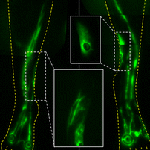A novel mutation in CELSR1 is associated with hereditary lymphedema
Main Article Content
Abstract
Background
Biological evidence reported in the literature supports the role of CELSR1 as being essential for valvular function in murine lymphatics. Yet thus far, there have been no variants inCELSR1associated with lymphatic dysfunction in humans.
Case Presentation
In this report, a rare early inactivating mutation in CELSR1is found to be causal for non-syndromic, lower extremity lymphedema in a family across three generations. Near-infrared fluorescence lymphatic imaging shows that instead of being propelled within the lumen of well-defined lymphatic vessels, lymph moved in regions of both legs in an unusual fashion and within sheet-like structures.
Conclusion
CELSRImay be responsible for primary, non-syndromic lymphedema in humans.
Article Details
How to Cite
GONZALEZ-GARAY, M. L. et al.
A novel mutation in CELSR1 is associated with hereditary lymphedema.
Vascular Cell, [S.l.], v. 8, n. 1, p. 1, feb. 2016.
ISSN 2045-824X.
Available at: <https://vascularcell.com/index.php/vc/article/view/10.1186-s13221-016-0035-5>. Date accessed: 28 dec. 2025.
doi: http://dx.doi.org/10.1186/s13221-016-0035-5.
Section
Case Report

